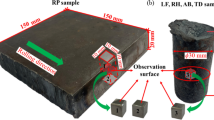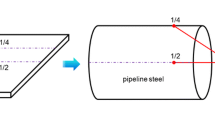Abstract
This is the first paper of a two paper contribution outlining the effect of inclusion morphology on elastic-plastic fracture toughness. In this paper, the effect of increasing hot deformation on the inclusion morphology of a semi-killed conventional (CON) X-70 pipeline steel was compared with that of a calcium treated (CAT) steel of the same chemical composition. Inclusion analyses at four stages of hot reduction of the CON steel viz S2 (38 pct reduced), S3 (70 pct reduced), S4 (88 pct reduced) and S6 (97 pct reduced) and two stages of reduction of the CAT steel viz C1 (63 pct reduced) and C2 (95 pct reduced) were accomplished using optical metallography, scanning electron microscopy (SEM), X-ray energy dispersive spectra (EDS), and electron-microprobe analyzing (EPMA) techniques. Quantitative analysis of the inclusion parameters, the area fraction (AF), the average inclusion length (Co), the inter-inclusion distance (D), the aspect ratio (FF), and the density of distributions (N) were carried out using a Quantimet 720 image analyzing computer and by direct microstructural measurements.
It was observed that silicate and sulfide inclusions in the CON steel undergo elongation as a consequence of hot rolling, whereas the inclusions in the CAT steel do not. In the CON steels, the (Fe, Mn) O · SiO2 phase constitutes the body of the inclusion with the MnS phase present as pockets within the silicate matrix. The CAT steels contain globular inclusions of calcium-aluminate (mCaO · nAl2O3) in the central part with (Ca, Mn) S and A12O3 on the periphery.
After 88 pct hot reduction of the CON steel the MnS phase remains equiaxed, while the silicate matrix “stringers out”, elongating in the rolling direction. At the lower reduction temperatures associated with increased hot reduction from 88 to 97 pct, the elongated silicate inclusions in the CON steel break down into small fragments and the MnS phase elongates.
Comparable hot rolling of the CAT steel produces no apparent change in the size or shape of the non-metallic inclusions.
Similar content being viewed by others
References
B. J. Edelson and W. M. Baldwin:Trans. ASM, 1962, vol. 55, pp. 230–250.
J. Gurland and J. Plateau:Trans. ASM, 1963, vol. 56, pp. 442–454.
F. B. Pickering: “Towards Improved Ductility and Toughness,” Climax Molybdenum Co. Symp. T.R. No. M-232, Kyoto, Japan, 1971, pp. 9–31.
W. G. Wilson and G. J. Klems:Ind. Heat., 1974, vol. 41, no. 10, pp. 12–17.
G. Bernard, M. Grumbach, and F. Moliexe:Met. Technol., 1975, vol. 2, pp. 512–521.
I. D. Simpson and J. Wilson: BHP Tech. Bulletin, 1979, vol. 23, pp. 24–32.
A. Brownrigg and F. M. Chalmers:JISI, 1970, pp. 1078–1082.
T. Gladman:Inclusion, F. B. Pickering, The Institution of Metallurgists, Monograph No. 3, pp. 157–171, London, 1979.
J. M. Hodge, R. H. Frazier, and F. W. Boulger:Trans. AIME, 1959, vol. 215, pp. 745–753.
R. Lagneborg: International Conference on Injection Metallurgy, Lulea, Sweden, 1977, pp. 1:1–1:15.
R. Lagneborg: Swedish Symposium on ‘Non-metallic inclusions in steel,’ URF and SIMR, April 1981, pp. 285–352.
A. D. Wilson:J. Eng. Mater. Technol., 1979, vol. 101, pp. 265–274.
P. P. Puzak, E. W. Eschbacher, and W. S. Pellini:Weld. J. Research Supplement, December 1952, p. 569S.
L. Luyckx, J. R. Bell, A. McLean, and M. Korchynsky:Met. Trans., 1970, vol. 1, pp. 3341–3350.
R. F. Smith and J. F. Knott: Conference Proceedings “Practical Application of Fracture Mechanics to Pressure-vessel Technology,” Institute of Mech. Engrs; 1971, pp. 65–75.
J. H. Little and W. L. M. Henderson: “Effect of second phase particles on the mechanical properties of steels,” ISI Pub., London, 1971, p. 182.
I. Kozasu and J. Tanaka: “Sulphide Inclusions in Steel,” ASM Pub., 1975, pp. 286–308.
L. G. Seraphin and R. H. Tricot:ibid, pp. 338–360.
J. C. Brunet, P. Torterat, M. Hugo, and J. Bellot:Revue de Metallurgie, 1977, vol. 74, no. 1, p. 1–9.
J. D. Boyd and K. M. Pickwick:Fracture 1977, ICF4, Waterloo, Canada, June 1977, vol. 2, pp. 377–385.
G. J. Roe:Metals Handbook, 9th ed., vol. 1, pp. 689–709. 1978.
W. G. Wilson and A. McLean: “Desulphurization of Iron and Steel and Sulphide Shape Control,” ISS of AIME Pub., 1980, pp. 2–40.
R. Maiti, J. S. Nadeau, and E. B. Hawbolt:J. Mater. Energ. Syst., June 1980, vol. 2, pp. 34–50.
P. McConnell, E. B. Hawbolt, and R. J. Cooke:ibid, vol. 3, September 1981, pp. 28–41.
R. Kiessling and N. Lange: “Non-metallic Inclusions in Steel,” p. 01, The Metals Society, London, 1978.
A. Gittins:Int. Met. Rev., September 1977, pp. 213–221.
T. J. Baker and J.A. Charles:JISI, September 1972, vol. 210, pp. 680–690.
T. J. Baker and J. A. Charles:JISI, March 1973, pp. 187–192.
W. J. McG. Tegert and A. Gittins: “Sulphide Inclusions in Steel,” ASM Pub., 1975, pp. 198–211.
S. Ekerot:Scan. J. Metallurgy, 1974, vol. 3, pp. 21–27.
J. A. Charles and I. Uchiyama:JISI, July 1969, pp. 979–983.
B. I. Klevebring:Scan. J. Metallurgy, 1974, vol. 3, pp. 102–104.
P. J. H. Maunder and J. A. Charles:JISI, July 1968, vol. 206, pp. 705–715.
W. J. M. Salter and F. B. Pickering:JISI, July 1969, pp. 992–1002.
T. J. Baker, K. B. Gove, and J. A. Charles:Met. Technol., April 1976, vol. 3, pp. 183–193.
R. Maiti: Ph.D. Thesis, The University of British Columbia, Vancouver, B.C., March 1983.
P. E. Waudby:Inclusions, F. B. Pickering; The Institution of Metallurgists, Monograph No. 3, 1979, pp. 94–107.
H. Nashiwa, R. Mori, S. Ura, T. Ikeda, H. Matsuno, and R. Ishikawa: Special report, Iron and Steel Institute of Japan, 6th Japan-USSR Joint Symp. Phy. Chem. Metall. Processes, 1977, pp. 81–94.
J. W. Farrel and D. C. Hilty:Iron Steelmaker, August 1976, pp. 17–23.
S. K. Saxena:Ironmaking Steelmaking, 1982, vol. 9, no. 2, pp. 50–57.
A. D. Wilson:Met. Progr., April 1982, pp. 41–46.
T. Nemura, H. Nashiwa, T. Ikeda, A. Mori, and M. Tokuda: AIME Proceedings Open Hearth Comm., 1976, vol. 59, pp. 457–478.
Chi-Hung Leung: Ph.D. Thesis, The University of Michigan, 1977, pp. 50–52.
Author information
Authors and Affiliations
Rights and permissions
About this article
Cite this article
Maiti, R., Hawbolt, E.B. The effect of hot rolling on the inclusion morphology of a semi-killed and a calcium treated X-70 pipeline steel. JMES 6, 251–262 (1985). https://doi.org/10.1007/BF02833514
Issue Date:
DOI: https://doi.org/10.1007/BF02833514




